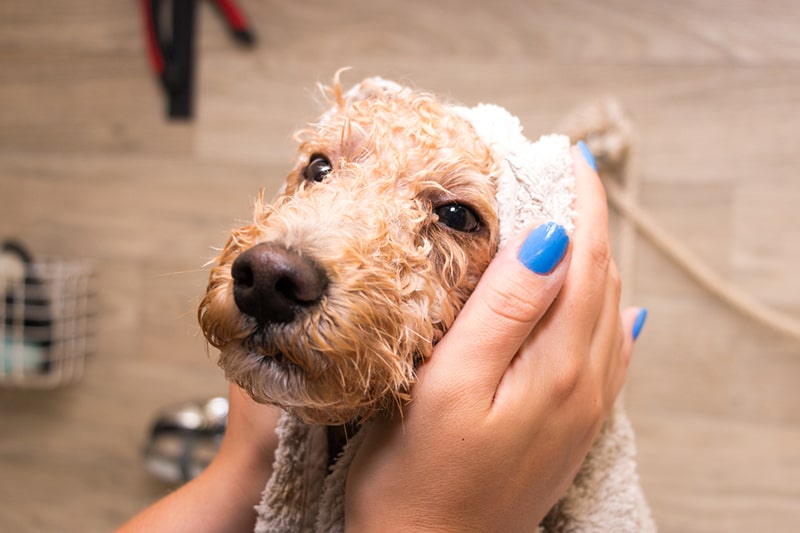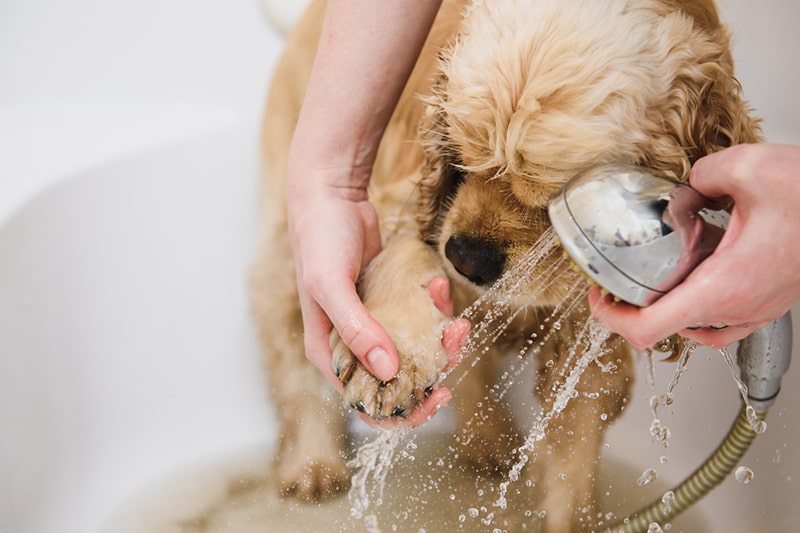Holiday Gift Guide for Cats
Discover a wide range of unique and practical presents that will delight feline friends and their owners alike with this holiday gift guide for cats.
So your dog rolled in something unidentifiable but definitely stinky or came home from a hike in the woods extra muddy. It’s now time for a bath and, whether your pooch likes it or not, it’s all part of being a dog parent! Dogs also need regular baths for the sake of general cleanliness.
Do you have what it takes to get the job done without getting soaked? Check out the answers to these common questions about how to give a dog a bath to find out.
The answer is that it depends on your dog, lifestyle, and environment. Many dogs do fine with one bath a month or even every few months. However, if your dog enjoys the great outdoors and loves nothing better than diving in the mud, swimming in the lake, or rolling around in whatever-the-heck-that-is, frequent bathing is probably necessary.
The ideal number of baths can also vary by breed. Breeds with an oily coat, like Bassett Hounds, may need to be washed more often. Wrinkly dogs can need baths more frequently than other breeds, along with a daily cleaning between those wrinkles to help avoid itchy skin and infections.
Keep in mind that dogs don’t need to bathe as much as people do. Too much bathing can dry out your dog’s skin. It also removes the natural oils that help keep your dog’s coat healthy and prevent dandruff. Talk to your veterinarian about how often you should give your dog a bath.

Shampoo, a tub, and a towel are really all you need to bathe a dog, but you can go a little crazy buying specialized items. Here are the basics of dog bathing supplies.
Don’t reach for the shampoo in your own bathroom. It may contain fragrances or other ingredients that can irritate their skin and cause an upset tummy if accidentally ingested. Instead, choose a brand that’s made for dogs and designed to give them the best possible cleaning with minimal skin irritation. If you’re confused by all of the options available, you can check with your veterinarian or a groomer about a good choice for your dog.
If your dog’s skin is especially dry, sensitive, or itchy, you can ask your veterinarian if a medicated shampoo might be helpful. There are a lot of varieties targeted toward different issues. Your dog could also have a common skin condition causing the issue, which may need to be properly diagnosed and treated.
While you don’t necessarily need to use conditioner on your dog, it can help keep that coat soft and silky, which is great for cuddle-time! Conditioner is also useful if your dog’s fur is longer and prone to matting. It can smooth, soften, and detangle the hair, making brushing afterward easier and less stressful for you and your dog.
Dogs with undercoats, like Golden Retrievers, can benefit from conditioner since that bottom layer of fur tends to be fine and prone to tangles. Again, it’s not a necessity. If your dog is ready to bolt after only a few minutes of bathing, you might want to skip this second step or look for a 2-in-1 product that shampoos and conditions at the same time.
Bathing your dog is a wet job, and you’re going to need a towel or two to dry your damp pooch when you’re done. You’ll probably need an additional towel for yourself, depending on how well your dog behaves during a bath. Lots of dogs can’t resist shaking that water off with a fast wriggle, in which case you’ll definitely need a towel of your own. You should also wear clothing that you don’t mind getting wet.

You’ll need a brush to get out the tangles before your dog’s bath. You can pick up a sturdy dog brush at a pet supply store. There are quite a few shapes and sizes, which can make it confusing to figure out which one is right for your dog, but really there are three main types:
The size and shape of the brush you pick should depend on the size of your dog and what both of you feel comfortable using. The color is up to you.
Not all dogs like a bath, especially at first. If your dog is ready to run for the hills when you get out the bath supplies, you should keep some treats on hand. Reward your dog with praise and a goodie for appropriate behavior during bath time.
Please keep in mind that treats can be packed with sugar and fats, so go sparingly unless you want your doggie to turn into a chunky monkey. You can also offer healthy treat options, like bits of cut-up apples or other pet-safe fruits and veggies.
A leash and collar can help you keep your dog safe during a bath and prevent dogs who are unhappy about bath time from making a getaway. Another option is to purchase special tethers, like the ones used by groomers, to hold your dog securely in the tub.
If your dog wears a leather collar, switch to nylon for the bath since leather tends to shrink when it gets wet. An ID tag is also important if you are bathing your dog outside. You never know when your wet dog might manage to slip away. In addition to an ID tag, you should consider microchipping your dog.
There are plenty of specialized items that can make bathing your dog safer and easier. For instance, you can purchase a non-slip tub or sink mat, shampoo mitt, special doggie shower sprayer, super absorbent microfiber towel, and pet hair trap to help keep your drain from clogging. These may or may not be useful depending on your dog’s bath time needs.

If you have a small dog, you’re in luck.
The sink in your kitchen, utility room, or bathroom can easily do the trick. Plop them right in and get to work. Just make sure you keep your little pal safe while they’re in the sink. You don’t want them to slip or climb out and get hurt.
Medium to large-sized dogs are going to need a larger tub. You can use the one in your bathroom if your pooch fits, and you don’t mind some hair in the drain.
You can also purchase a tub at a pet supply store. Some portable tubs are collapsible, which is great if you live in an apartment or small home without a lot of storage. The good thing about a portable tub is that you can use it anywhere it will fit—in the bathroom, basement, or outside if the weather is nice.
Speaking of bathing outside, it can be tempting to hose your dog down, especially after a particularly dirty outing. While this can be okay every once in a while and if your dog doesn’t mind, but remember that hose water can be painfully cold and rough. Would you like it if someone sprayed chilly hose water at you?
Giving your dog a bath is pretty straightforward, but it can be a bit tricky depending on your dog’s size, temperament, and general opinion about bathing. Some dogs love a good bath, while others really dislike them. Here are the basic steps.
Before you get started, make sure you have everything you need nearby. The last thing you want to do is get your dog all wet and then realize you forgot a towel.
You’ll need to give your dog a good brushing before bathing to remove loose hair, dirt, and dander. Try to work out tangles slowly and carefully to keep from hurting or upsetting your dog. You want brushing and bath time to be enjoyable activities. This is also a good time to check for fleas and flea dirt, which are those little black specks fleas leave behind.
Wet your dog’s fur using lukewarm water to avoid overheating or drying out the skin. Suds up your pup with a dog shampoo and massage the soap in gently from head to tail. You can use a washcloth on your dog’s face to help keep the soap from getting into the eyes, ears, or mouth, which can be irritating.
For added protection, you can place large cotton balls in your dog’s ears and consider using a sterile eye lubricant. Eye irritation can happen more easily in breeds that have protruding eyes, like Pugs and Chihuahuas.
Do your best to rinse off all of the leftover soap. Soap residue can irritate your dog’s skin. Your dog might also lick it off and ingest the leftover soap, which isn’t a good idea. A hand nozzle can be helpful to get the job done. Just be careful not to spray directly into your dog’s face.
If your dog is particularly dirty or hasn’t been bathed in a while, you may need a second round of shampoo and rinsing. Once you’re done with the shampoo, you can use the conditioner if you decide it would be helpful. Rub it in and rinse it off the same way you did with the shampoo.
If your dog has long hair, it can be helpful to squeeze out excess water with your hands. Then use a towel to dry your dog thoroughly. Your pooch may want to help out with a big wet shake, so watch out for flying water! For wrinkly dogs, be sure to dry between all those nooks and crannies to help avoid skin issues.
You can use a dog blow dryer, which uses less heat than a human hairdryer and is less likely to injure your dog. However, a dog blow dryer is still hot, so be careful when you use it and stick to towel drying if your dog dislikes the noise and hot air. If your dog has dry or sensitive skin, you should definitely skip the blow dryer since it can further dry out and irritate the skin.

Of course, this isn’t always the case. Lots of dogs love a bath, and the extra attention that comes along with it. But some dogs do not enjoy it at all. If your dog doesn't like bath time, these tips can help:
If you’re still having trouble, you can ask your veterinarian for advice or contact a dog trainer, animal behaviorist, or groomer. You might want to watch a professional give your dog a bath, so you can learn some useful tricks to make the experience easier for you and your pooch.
You can follow the same steps to bathe a puppy, but take extra care to make sure your puppy doesn’t get hurt. Puppies tend to think bath time is silly time and bounce around the tub. They may also nip at you playfully while you try to soap them up and rinse them off. If your puppy isn’t behaving in the tub, you can offer a bath toy to chew on and distract them during the process.
The information presented in this article is for educational and informational purposes only and does not constitute or substitute for the advice of your veterinarian.